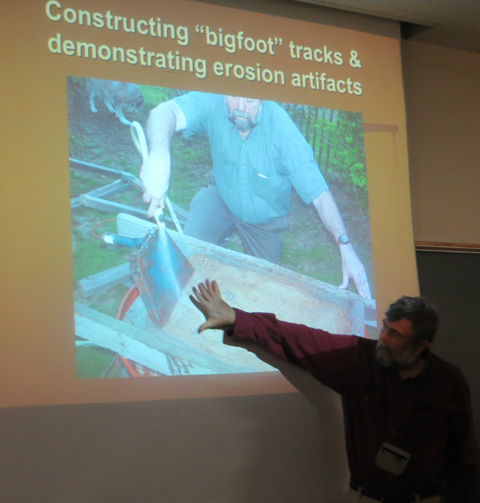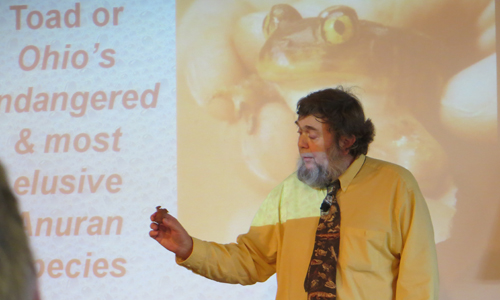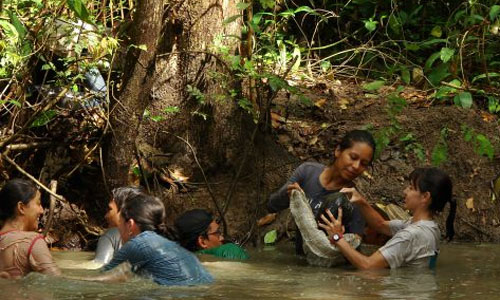DNA evidence has gotten felons off death row. Could it be about to get Sasquatch onto the list of newly discovered species?
Dr. Scott Moody has been teaching and researching various topics of biology at Ohio University for 35 years. For the last 15 years or so, when he took over the forensic biology course, he’s been looking at Bigfoot evidence—from a scientific perspective. “I did open up my scientific mind and started looking at the evidence,” says the Associate Professor of Biological Sciences.
He’s given the talk on Sasquatch many times, but on Wednesday he updated it with an announcement from the Sasquatch Genome Project.
Hoaxes and fakes may have clouded the picture—and kept many scientists from looking at the facts, but DNA research published this week claims to identify a new relative of Homo sapiens.
Despite the fact that it was rejected by peer-reviewed journals, the DNA evidence could tell the tale of a new species. Would 10 lab scientists put their names on a report of dubious origins? Is it even possible to fake DNA evidence?
“How would you pull together a whole group of professionals from reputable labs? What is the probability that everyone is going to join in on a fraudulent paper?” Moody notes. “I would say no.”
“Sometime in the past, a female human mated with a different ape species, and all of the Sasquatches are descendants,” concludes the published DNA report.
Do You Believe?
Scientists don’t “believe” in things, Moody says, not even gravity and evolution. They investigate and test hypotheses with evidence and assess the probability of truth or falseness.
In literature and anthropological art, accounts of Sasquatch go back thousands of years. The advent of mass media has caused a jump in sightings in the past few decades, he notes, but our ancestors didn’t have TV shows and hoaxes to spur their imaginations. “Every native American tribe had a name for a large, hairy, bipedal creature in the woods. The same is true for Europe and Asia.”
When 18th century Swedish botanist Carl Linné developed the modern system of classification of plants and animals, he included a “four-footed, mute, hairy wild man” category, a description that persists in European and Asian legends of a feral or wild human.
A 16th century manuscript from Germany, pictographs on the Tule River Indian Reservation, and other historical records tell a compelling story. But today’s researchers have a plethora of scientific tools to put Bigfoot to the test.
It can be pretty easy to explain some sightings, says Moody, who has been called upon to investigate Ohio claims.
Sorry, folks, if you were hoping for Bigfoot in the woods around Athens. Those toe-like footprints were caused by rainwater washing around pebbles in the clay, he demonstrated. That white creature attacking a bird feeder—a white-tailed deer standing on its hind legs, according to the hairs found on the feeder.
And those increased sightings reported in Ohio in the last 15 years? “The first thing that came to my mind—people were seeing black bears,” he said. “They can stand on their hind legs and walk bipedally.”
Overlay a map of the Bigfoot sightings with a map of the influx of black bears back into Ohio’s regenerating forests, and, yep, they align pretty well. And unlike the temperate forests of the Pacific Northeast, Moody notes, Ohio’s forests also might not have the biodiversity necessary to feed Bigfoot.
Plus, he notes, “I have to put eye-witness sightings way down on the list of evidence.”
What about Film and Photographic Evidence?
When Ray Wallace died, he instructed his family to release the evidence of his 1958 hoax film from a logging camp in Northern California, notes Moody.
Recent additions to the video record include trail cams, with some video attributed to black bears with mange, yet clouded by extremity analysis of proportions and bears. “We haven’t found any films to just scream out and say this is the real deal,” he says.
But a recent paper by Bill Munns and Jeff Meldrum looks at another popular film—the Patterson film of 1967—analyzed from the perspective of suit vs. body and how fat folds and muscles ripple and whether the motion shows fat adhering to skin or a costume hanging on a body. The evidence indicates subcutaneous adipose tissue adhering to a body, not a body inside a furry suit of fabric.
“Therefore, I think the Patterson film is authentic,” Moody notes.
There are now 26 distinct species of hominids described scientifically since diverging from a common ancestor with the chimp-bonobo clade. Good candidates for Sasquatch include Homo erectus, Paranthropius boisei, Flores man (which only died out 3,000 years ago), and Gigantopithecus blacki (extinct for a million years or so).
“One of the things that I’ve been looking at is the structure of the head in reported and historical sightings,” notes Moody. In orangutans and humans, there is a naked forehead with hair combed forward, which is not a characteristic of chimpanzees or gorillas.”

Dr, Scott Moody shows his demonstration of how “footprints” were made by water erosion around pebbles.
Footprints, DNA…
But easy answers are not the case for some of the evidence, including the newest tool in the scientific kit—DNA analysis.
Footprints are pretty easy. Discerning a print made by someone wearing a piece of wood cut in the shape of a big foot can be told from an actual print made by an animal whose foot bends flexibly while walking, for example. But would a hoaxer at a time before fingerprint analysis became the stuff of detective shows take the time to carve lines into his fake bigfoot before his trek in the woods?
“They weren’t watching Disney or the History Channel to get the ideas into their heads,” Moody says of the huge increase in sightings in recent decades. “Yet newspaper accounts go back to the 1800s and 1700s. Two hundred years ago they were not going to imagine that event because they’ve been watching TV. Today, I have to dismiss recent accounts.”
And would people reporting sightings of Sasquatch take the time to make sure that their estimates matched up with Bergman’s Rule of natural selection, which predicts that animals in northern climes will be larger and bulkier in order to protect against the cold weather while the same species living in more tropical environments will be shorter and thinner to deal with the heat.
Yet, Moody showed, the reported sightings averaged together followed Bergman’s Rule. Bigger animals in the north, ranging to smaller estimated sightings in the south.
No Bodies? No Skeletons? So You Don’t Believe?
Don’t be so sure, Moody says. A Homo erectus foot bone on display at the Mexico City Museum can be aligned more easily with European and Asian Homo erectus than with human or other remains found in the Americas. The Loess Man found near Omaha in 1894 has the brow oft seen in Sasquatch depictions.
“Did I ever find a black bear skeleton while hiking in the woods? Absence of evidence does not signify that that organism doesn’t exist,” Moody says.
In a court of law, you need the body to prove murder, he notes. But scientists don’t always have a body; they have to work with the available evidence. Like hair.
DNA: A Red-Haired Sister to Humans?
Part of Moody’s scientific analysis of Bigfoot evidence involves hair analysis. He has been sent hair samples from multiple sites, but these were either clearly human or non-ape mammals. Three hairs sent to him from Canada collected from a shelter where a “bigfoot” was filmed were either wolverine or mink hair. Dr. W. Henner Fahrenbach, a retired anthropologist, has published on hairs coarser than human lacking medullas and colored reddish-brown. The microscopic features aligned the hairs closest to orangutans found in Southeast Asia, but these hairs came from shelters in wilderness forests of northern California.
The hair samples in the DNA article released last week have characteristics similar those published by Dr. Fahrenbach.
Research released this week by the Sasquatch Genome Project shows the mitochondrial DNA whole genome haplotypes are consistent with modern humans. The nuclear DNA in some samples possesed the melanocortin allelic variant for red hair, a common trait reported in sightings. But the nuclear DNA is not all human.
“Their findings show a mitochondrial DNA link to humans. Keep in mind that mitochondria always come from the maternal lineage so these haplotypes are ‘human European or Asian descent,’” Moody says.
“But the nuclear DNA has novel sequences that are different,” Moody says. “Sometime in the past, a female human mated with something else, and all of the Sasquatches are descendants apparently.”
“I’m 2.9 percent Neanderthal,” says Moody, who has had his DNA analyzed for ancestors.
“This month, Dr. Bryan Syckes’ genetic lab at Oxford University in Britain is due to report its findings,” he says. “If he can affirm and replicate the Texas group, then it’s clear that Sasquatch is authentic.”




















7 Comments